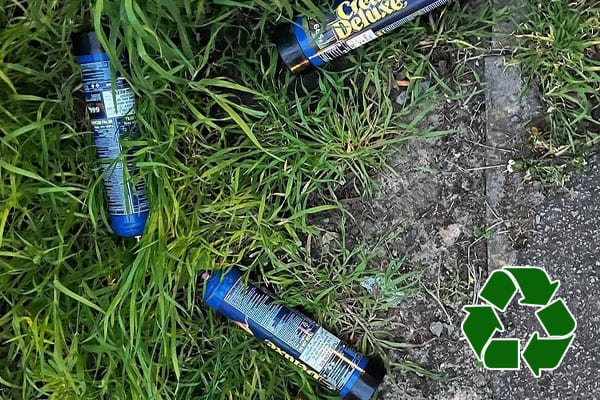Cream chargers are widely used in the food industry, but many buyers wonder if they can be refilled or reused to save costs. Some believe refilling is possible, but this poses serious safety risks. Misuse can lead to gas leaks, weakened cylinder walls, and even explosions.
No, cream chargers are not refillable. They are designed for single use only. Refilling can cause pressure failure, leaks, or cylinder rupture, making it extremely dangerous. Always dispose of used chargers properly according to safety guidelines.
You must handle and dispose of cream chargers correctly to be safe, legal, and environmentally friendly. Many people have trouble with these things, so in this article, I’m going to answer some common questions about how to use them safely, recycle them, and dispose of them.
How to Safely Dispose of Used Cream Chargers?
Used cream chargers still have pressure in them even after you release the gas. If you don’t get rid of them properly, they can be dangerous or bad for the environment.
Used cream chargers should never be thrown into regular trash. If local recycling is unavailable, they should be taken to a hazardous waste facility. Always check your local waste management regulations.
If you’re doing a lot of them, you should work with a licensed recycler to be legal and not hurt the environment.
How to Recycle Empty Cream Chargers?
After you use a cream charger, there may still be gas inside. You have to be careful when you recycle them because they can be dangerous.
- Ensure the charger is completely empty – Put it on a whipped cream dispenser to let all the gas out safely.
- Check recycling center policies – Some places want you to puncture the charger to make sure it’s safe to process.
- Drop off at a metal recycling facility – Cream chargers are made from 100% recyclable steel. They should never go in the trash.
If you’re a business and you have a lot of empty chargers, it can be hard to deal with them. Many industrial recycling partners have programs where they’ll come pick up your empties in bulk. It’s cheap, and it’s the right thing to do.
What to Do with Damaged Cream Charger Cylinders?
Cream charger cylinders are made of high-pressure steel, but they can get damaged from being dropped, stored for a long time, or having transportation issues. If you have a dented, rusted, or cracked charger, it’s not safe to use.
Damaged cream charger cylinders should not be used or stored with other chargers. They should be safely disposed of through a metal recycling center or hazardous waste facility. Do not attempt to release gas manually, as weakened cylinders may rupture under pressure.
If a cylinder looks weird, rusty, or messed up, you need to be careful with it and keep it away from heat. If you’re getting a lot of them, you should check them all the time and throw away the ones that are messed up. That way, you don’t blow yourself up.
For safe disposal:
- Identify the damage – Look for dents, rust, cracks, or leaks before handling.
- Isolate damaged chargers – Store them separately in a well-ventilated area.
- Follow local disposal regulations – Contact a licensed recycling center or hazardous waste facility for safe disposal.
Can Cream Chargers Expire or Go Bad?
People always ask, “Do cream chargers have an expiration date?” They think the gas goes bad.
Cream chargers do not have an expiration date because nitrous oxide gas remains stable. However, improper storage can cause rust, corrosion, or leaks, making them unsafe to use.
To ensure safety:
- Store in a cool, dry place – Avoid high humidity and direct sunlight.
- Keep upright and away from impact – Prevent dents or damage.
- Check for rust or deformation – Do not use damaged chargers.
Is Laughing Gas Explosive?
A lot of people think of compressed gases as being dangerous because they can explode. Since whipped cream chargers contain nitrous oxide (N₂O), some people wonder if they can explode under certain conditions.
Nitrous oxide is not explosive under normal conditions. However, it is an oxidizing gas, meaning it can intensify combustion if exposed to open flames or high heat. If a cream charger is punctured or heated excessively, the pressure buildup can cause the cylinder to rupture, posing serious risks.
While N₂O itself doesn’t burn, it can make other things burn faster. That’s why it’s important to store and handle it properly.
Safety Precautions for Businesses Handling Large Quantities of N₂O:
- Store away from heat sources – Avoid exposure to direct sunlight or open flames.
- Keep in a well-ventilated area – Prevent gas buildup in case of leaks.
- Never tamper with pressurized cylinders – Damaged or overheated chargers can rupture violently.
When used correctly, nitrous oxide is safe to use in food service. However, businesses need to follow the proper storage and transportation rules to avoid accidents.
Conclusion
Cream chargers are single-use. You should never refill them. Proper disposal and recycling keep you safe and keep you from adding to the waste in the world. They don’t go bad, but if you don’t store them right, they won’t work. Trust me, I know. You have to be safe with them. If you need help, let me know. I can help you with compliance and recycling.




